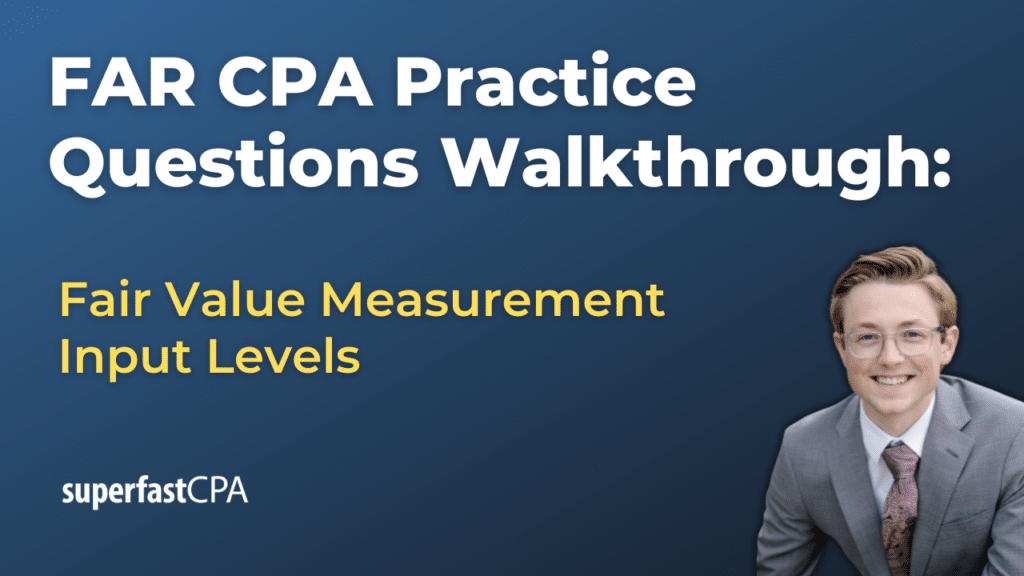In this video, we walk through 5 FAR practice questions about the different fair value measurement input levels (hierarchy). These questions are from FAR content area 3 on the AICPA CPA exam blueprints: Select Transactions.
The best way to use this video is to pause each time we get to a new question in the video, and then make your own attempt at the question before watching us go through it.
Also be sure to watch one of our free webinars on the 6 “key ingredients” to an extremely effective & efficient CPA study process here…
Fair Value Measurement Input Levels (Hierarchy)
The fair value measurement input levels or hierarchy is an essential framework in accounting and financial reporting, providing guidance on how to measure and disclose fair value. Established under GAAP (and consistent with IFRS), the hierarchy categorizes inputs into three levels based on their observability and reliability.
What is Fair Value?
Fair value represents the price that would be received to sell an asset or paid to transfer a liability in an orderly transaction between market participants at the measurement date. The measurement should prioritize observable market data whenever available and rely on unobservable inputs only when necessary.
The Three Levels of the Fair Value Hierarchy
Level 1 Inputs: Direct Market Evidence
Level 1 inputs are the most reliable and straightforward. These are quoted prices in active markets for identical assets or liabilities that the entity can access at the measurement date.
Example:
A company owns shares in a publicly traded company listed on the New York Stock Exchange. The closing stock price of these shares on the measurement date represents a Level 1 input.
Key Characteristics:
- Based on observable, real-time market data.
- No adjustments needed.
- Examples: Stocks, mutual funds, and commodities traded on active exchanges.
Level 2 Inputs: Observable but Indirect
Level 2 inputs include data that is observable but not derived from quoted prices for identical assets. These inputs often involve adjustments for differences in assets or markets.
Example:
- A real estate company values a building using recent sales data for comparable properties in the same area but adjusts for differences in square footage or condition.
- A corporate bond’s valuation uses market yields for bonds with similar credit ratings and maturities.
Key Characteristics:
- Observable but may require adjustments.
- Includes data such as quoted prices for similar assets, yield curves, or credit spreads.
- Examples: Comparable real estate sales, interest rates adjusted for credit risk, and market-based bond yields.
Level 3 Inputs: Unobservable and Subjective
Level 3 inputs are used when observable market data is not available. These inputs rely on the entity’s own assumptions about market participants’ expectations, often involving significant judgment and estimation.
Example:
A company values a custom piece of machinery for which no active market exists. Using a discounted cash flow model based on management’s projected cash flows and an internally developed discount rate represents a Level 3 input.
Key Characteristics:
- Based on internal data and assumptions.
- Used for unique or illiquid assets.
- Examples: Discounted cash flow models, internally developed pricing models, and valuations for privately held equity.
Why the Hierarchy Matters
The fair value hierarchy ensures consistency and comparability in financial reporting by requiring the use of the most reliable inputs available. Level 1 inputs are prioritized, followed by Level 2, and then Level 3 as a last resort. This hierarchy also provides insight into the quality and reliability of the fair value measurements presented by a company.
Examples in Practice
- Investment Portfolio Valuation:
- Publicly traded stocks (Level 1).
- Private equity investments valued based on market comparables (Level 2).
- Start-up equity investments using internal forecasts (Level 3).
- Real Estate Appraisal:
- Quoted prices for identical buildings in an active market (Level 1).
- Adjusted sales data for similar buildings (Level 2).
- Custom commercial property valued using cash flow projections (Level 3).













